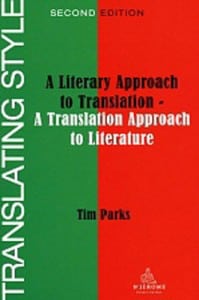 One wet Thursday, as it were, many years ago, I decided to give a group of students a piece writing in Italian and English. They had to decide which language was the original, which the translation. It was an odd piece and they soon found the four or five places where the texts were different. They opted for the Italian, which seemed all proper and correct. The English was bizarre to say the least. It included the expression ‘he shut himself together.’ It was D.H. Lawrence.
One wet Thursday, as it were, many years ago, I decided to give a group of students a piece writing in Italian and English. They had to decide which language was the original, which the translation. It was an odd piece and they soon found the four or five places where the texts were different. They opted for the Italian, which seemed all proper and correct. The English was bizarre to say the least. It included the expression ‘he shut himself together.’ It was D.H. Lawrence.
I was fascinated. Infallibly, by finding where translation differed from original, students whose English was far from perfect were able to identify those places where a writer diverged from standard usage. The reason is evident enough. While it’s fairly easy to translate content and standard mannerisms, when the meaning of a text lies in the distance between itself and what the reader expected, then it is difficult for translator to follow. Looking at all the ways a translation differs from its original, you can begin to get a good sense of how a writer worked and what his particular take on language and indeed life was. Because for each author who has anything interesting to say, the problems are always different. That’s what this book is about.
There are chapters on Lawrence, Joyce, Woolf, Beckett and various other authors, which are at once essays on translation, and on the authors concerned. Each chapter interconnects with the others, and I hope at that by the end of the book the reader will have a sense of the way, however intimate the translator may become with the writer, there is always a huge distance between original and translation. Which isn’t a reason for not translating.
Author’s note to new edition
This is a completely revised edition of a book written ten years ago. As such it represents a radical attempt to extend the book’s readership, to move it out of a niche and put it in the way of any reader interested in style, language and literature.
Why was this necessary? Translating Style was never an overly academic book. It was never jargon bound. I had wanted to show how the experience of translation can tell us a lot about literature, give us insights into the books we love that we will not pick up from regular criticism. And I wanted to suggest that an understanding of literary strategies is essential for the translator. The only way to do this, I thought, was by analysing extended examples of stylish writing, together with their corresponding translations. To draw in as many people as possible I chose authors and books that many readers would be familiar with: the great modernists in particular: Lawrence Joyce, Woolf, Beckett, plus two favourites of mine, Barbara Pym and Henry Green. The problem was that since I looked extensively at Italian translations of those books (Italian being my second language), readers with little or no Italian would feel left out. I resigned myself to the idea that, for better or worse, such a book could only appeal to a limited audience.
Yet again and again, over the years, people with no Italian at all told me they had read Translating Style and found it fascinating. If only, they said, they could get a slightly better sense of the trans-formations that had taken place in the Italian translation! This edition attempts to meet the needs of these readers, to demystify the Italian translations and hence to make my comments on the original English texts more persuasive.
How? Imperfectly no doubt, using back-translations and, occasionally, glosses. From the second chapter on, from the point that is where we begin to discuss the work of our six chosen authors, every passage of Italian translation is followed by a back-translation, which is to say by the same passage returned (back-translated) into English. This allows the reader to see what changes in diction, focusing, imagery and content have occurred in the Italian versions. These are not literal or word-for-word back-translations, but nor are they attempts to return the Italian to stylish English. They simply seek to show what the Italian reader is getting in terms of information and its arrangement. Where necessary, a word-for-word gloss is given of some key Italian phrases.
It will sound laboured perhaps, but the intention is always to have fun, to sharpen the mind through a reflection on how the reading experience is constructed. The translation, or for those with no Italian, the back-translation, serves as a short of shadow text, or simply alternative, comparison with which gives us new insights into the English original.
Translating Style also has an underlying polemic that emerges in a final chapter written specifically for this edition. One of the effects of globalisation has been that more literature – novels, plays and poetry – is translated than ever before. Often translations are published simultaneous with publication in the original language. Thus the community to whom a writer addresses his work is no longer specifically national, but international, multi-lingual. The last chapter considers the consequences of a situation where writers often work with eventual translation in mind and readers, particularly outside the English-speaking world, read most of their literature in translation. It is quite possible that this will change the way language is used in literature, and indeed the very content of the books we read.

z285nf
0axiua
7cq5cb
cagctv
qb45f0